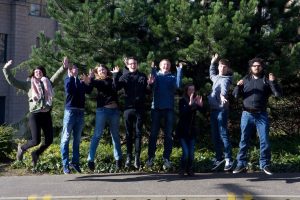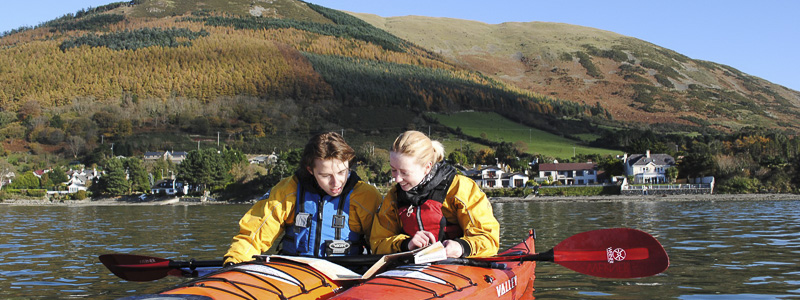By Louise Macdonald, Chief Executive of Young Scot.
(in Volume 28)
Young people should take the lead
Seeing more young people out enjoying the outdoors and our wonderful green spaces is an important area in Scotland for charities, public bodies and national and local government across Scotland. There is widespread recognition of the mental and physical health benefits, especially for young people, and by encouraging young people to get outdoors positive behaviours are created that can last a lifetime.
In Scotland, young people involved in the Duke of Edinburgh Award last year took part in nearly three million hours of activity (5). Participation in the John Muir Award is up by 15 per cent in Scottish schools. Importantly disadvantaged pupils now account for one in five of the 16,000 Joh Muir Awards achieved in 2016 (6).
This is backed up by the recent ‘Young People and Nature Insight Briefing’ by ReRoute – Scotland’s national youth biodiversity panel. ReRoute surveyed 1103 young people aged 11-25 in Scotland. They found that young people are getting the message about nature:
- 74% of young people agree or strongly agree that they enjoy spending time in nature.
- 76% consider nature to be important to them
ReRoute, who are supported by Young Scot, Scotland’s national youth information and citizenship charity and Scottish Natural Heritage are looking at how to get young people more engaged in nature and biodiversity.
Their research shows that young people do care about being outdoors. However the majority of young people spend only one to three hours in nature per week.
How can you turn this awareness into action?
The secret is to work with young people to not only find out how to better communicate with them but also how to create campaigns and services that meet their needs. There are no shortcuts here but there are great examples to follow.
Policy Change
If policies are to be a success they need to address the real issues and real opportunities faced by real people. If you aren’t listening and involving the right people in helping to shape policy you are risking interventions simply not working, being rejected due to how they are positioned or prioritising the wrong areas.
As part of a forthcoming report by Young Scot to Scotland’s Natural Health Service – a plan to use Scotland’s outdoors to promote positive health outcomes – Young Scot held workshops with a group of young women to discuss the barriers that prevent them from using green and blue spaces. Freshspace: Young Women’s Engagement (3) will be published online soon and the findings are useful for anyone looking to make policy decisions about how to encourage young women to enjoy outdoor spaces, especially those spaces on their doorsteps.
The young women highlighted the social element of spending time in the natural environment. They also spoke about specific expectations of girls to study, to keep clean and tidy and to stay indoors compared to boys who are expected to play outside, get dirty, and let off steam.
There was also a particular perception of ‘outdoorsy types’ of women and some young people want to avoid this label. A lack of female role models in outdoor settings was also identified.
Body image, personal care and hygiene was also a major consideration. Periods pains and lack of access to toilet facilities during their period were reasons why young women avoid being active outdoors.Young women may also need to change into a sports bra before participating in most outdoor activities. Issues around body image and confidence, such as feeling a pressure to shave body hair, to wear make-up, or being too self-conscious or insecure to exercise in front of others were also pressures discouraging young women from being outdoors.
In Freshspace, the young women also expressed a variety of additional practical barriers that may stop them from making use of outdoor spaces. These included;
- Lack of time due to busy schedules and a pressure to study
- The (perceived) cost of participating in activities or joining groups that use the outdoor spaces
- Access to equipment and clothing required for enjoying outdoor spaces (for example sports bras, trainers, waterproof jackets)
- Availability of sports or activities that the young women were interested in
- Transport and distance to green spaces
- Lack of facilities or information for someone with an illness or disability
Interestingly, some of these practical barriers only apply to organised events, activities or sports. There was less recognition of green and blue space as somewhere free and readily available for everyone to enjoy.
Communicating with young people
As with all audiences it’s important to communicate in a way and at a time that is right for the audience. Interestingly the report by ReRoute found that the most popular source of information about nature was television. This was markedly different for 21-25 year olds who relied more on social media.Social media has undoubtedly changed how we all consume information, even more so for young people who consume more via social media platforms, tablets and mobile phones than the generations before them (4).
Many campaigns struggle by not involving their audience right from the start. If you are looking to run a low budget social media campaign you can take a lesson from those with deeper pockets and work with your audience to create the content you need. This is far more effective than a top down educational campaign.
A great example of including young people in a campaign is some recent work between Young Scot and Save a Life for Scotland (www.young.scot/cpr) to help young people to say “I’ll do it” and save a life by learning CPR and having the confidence to use the skill. In a video for the campaign, Elidh, a young woman, shares the real 999 call that helped save her dad’s life. Creating social media friendly content that uses real young people can be a powerful way to engage others in a campaign.
Changing behaviours
In May 2017, Young Scot launched a ‘Supporting a shift in attitudes and behaviours to littering in Scotland’ a report by Generation Change, a group of young were looking at how to lead the fight against litter in a bid to drive behaviour change across Scotland.
Their ideas include introducing an app to show young people where the closest bins are, and making bins across Scotland more colourful and visible to encourage people to use them. Other ideas include public art projects to highlight the community impact of littering, and creating a national education campaign.
There ideas are full of creativity and practical measure to move the need on behaviour change.
Of course their ideas need to be heard at the highest levels if they are to have an impact. The report has been presented to the Scottish Government and the board of Zero Waste Scotland to inform their future strategies.
If you take away one thing…
Young people have a connection to nature and it is very possible to encourage them to be outdoors more. No matter your objective, the starting point is the same: you need to work directly with young people.
This isn’t just about just listening to them, although that is an excellent start, it’s about involving them in co-design, that involves giving them the opportunity to immerse themselves in a topic before creating and coming up with ideas for you to use. In return they will help you make better decisions and overcome many of the challenges you face.
There are organisation like Young Scot and our partners that are here to help. You can also look to your youth work sector to find groups of young people who are more than ready help or you could employ a Modern Apprentice to bring in some of the skills you might be missing when it comes to communicating with young people.
Amongst all of the great things the young people involved in Young Scot projects achieve, they share an amazing quality; they impress all of the organisation that work with them. You should give young people the opportunity to impress you too.
Footnotes
1. ReRoute (2017), ‘Young People and Nature Insight Briefing, [online]. Last accessed on 29 June 2017 at URL: http://www.youngscot.net/wp-content/uploads/2017/01/ReRoute_Insight_Report_G.pdf
2. Generation Change (2017) ‘Supporting a shift in attitudes and behaviours to littering in Scotland ‘ [online] Last accessed 29 June 2017 at URL: http://www.youngscot.net/wp-content/uploads/2017/05/Generation-Change-Document_Spring_2017.pdf
3. Young Scot (2017) ‘Freshspace: Young Women’s Engagement in Nature.’ To be published soon. For an advance copy please email info@young.scot.
4. Ofcom (2016), Children and parents: media use and attitudes report 2016 [online]. Last accessed 29 June 2017 at URL: https://www.ofcom.org.uk/research-and-data/media-literacy-research/childrens/children-parents-nov16
5. The Duke of Edinburgh Award (2016), ‘Submission of Evidence Scottish Parliament Education and Culture Committee – Educational Attainment Gap, Role of the third and private sectors’ [online]. Last accessed 29 June 2017 via http://www.parliament.scot/S4_EducationandCultureCommittee/Educational%20attainment/TheDukeofEdinburghsAward2.pdf
6. John Muir Trust (2016), John Muir Award growing by 15% a year in Scottish schools [online]. Last accessed 29th June 2017 via https://www.johnmuirtrust.org/latest/news/1004-john-muir-award-growing-by-15-a-year-in-scottish-schools

